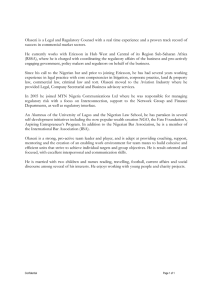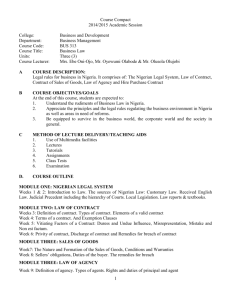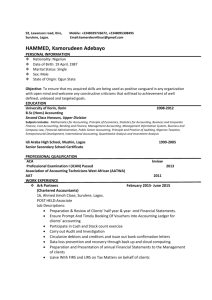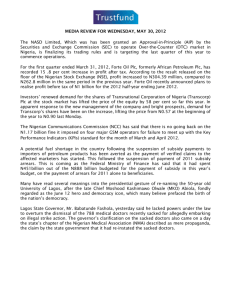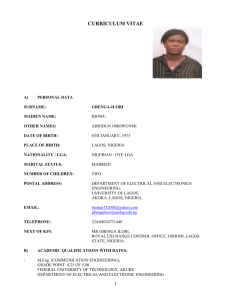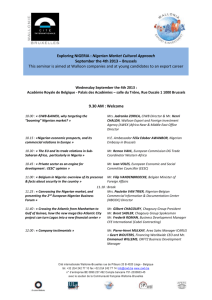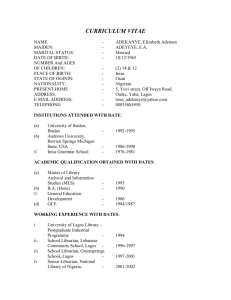Power Sector Opportunities - Detail Commercial Solicitors
advertisement
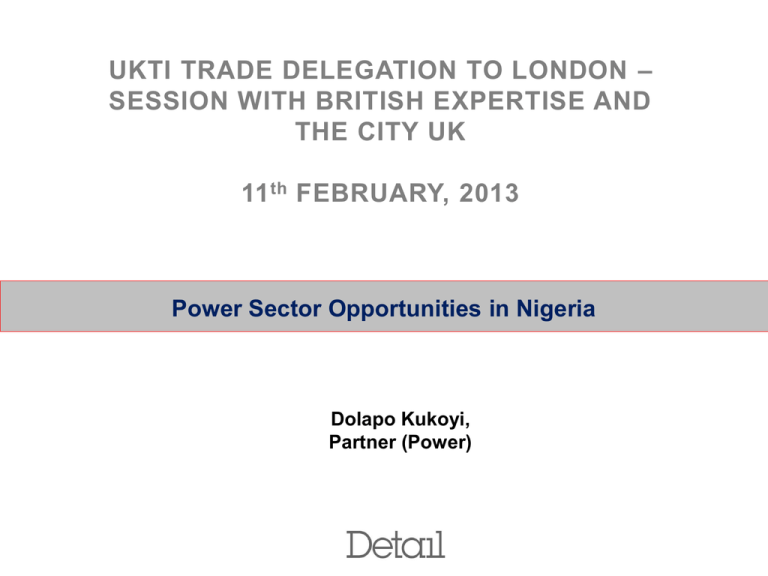
UKTI TRADE DELEGATION TO LONDON – SESSION WITH BRITISH EXPERTISE AND THE CITY UK 11 th FEBRUARY, 2013 Power Sector Opportunities in Nigeria Dolapo Kukoyi, Partner (Power) 0 Outline 1. Brief History of the Nigerian Power Sector 2. Nigerian Power Sector Outlook 3. Power Sector Opportunities 4. Legal, Regulatory and Contractual Framework 1 Brief History of the Nigerian Power Sector 2 Brief History of the Power Sector A monopoly run by a single government owned utility company handling generation, transmission and distribution of Electricity. Single Utility Company progressively incapable of handling power demands with rising population. By 1999, NEPA at the time had an imminent complete system failure Power Sector Reforms in 2005; creation of PHCN, unbundling of Generation, Distribution and Transmission businesses and creation of successor companies and regulatory framework Privatization Process suspended in 2007 restarted in August 2010 3 Nigerian Power Sector Outlook 4 SOKOTO ZAMFARA JIGAWA YOBE KASTINA BORNO KEBBI Gombe Niger BAUCHI KADUNA Plateau KWARA ADAMAWA ABUJA NASARAWA Kogi OYO TARABA EKITI OSUN Ogun BENUE Ondo Edo FGN Gencos Enugu Lagos Cross River Delta Abia Imo Bayelsa Rivers AkwaIbom Power Generation Legend FGN NON OPERATING GENCOS Operating IPPs ,bDKDKO Non Operating IPPs Operating NIPPs Non Operating NIPPs 5 EMBEDDED GENERATION FUEL SOURCES SOKOTO JIGAWA ZAMFARA YOBE KASTINA BORNO KEBBI GOMBE BAUCHI KADUNA NIGER Plateau KWARA ADAMAWA ABUJA NASARAWA OYO TARABA KOGI EKITI OSUN OGUN BENUE ONDO EDO Coal Deposits ENUGU LAGOS Hydro Projects ANAMBRA DELTA IMO Alternative Fuel Sources Legend ABIA CROSS RIVER ,bD Colours: K00 Coal Water BAYELSA RIVERS AKWA IBOM Gas Nigerian Power Sector Outlook – National Power Sector Road Map aspiration – 40,000 MW by 2020 Presidential Taskforce on Power – 30,669 MW by 2020 Daily Peak Delivery as at December 2012 – 4300 MW ( ± ), 32 Licensed On -Grid IPPs with a total installed capacity of ±1879 MW total licensed capacity 12,324 MW 21 Licensed Off – Grid IPPs with a total installed capacity of ±111.15 MW; total licensed capacity 284.5 MW 3 EG Licenses with a total licensed capacity of 263 MW – All Non-Operational 4 NIPP Projects currently operative with a total installed capacity of 5,625MW, Generating Capacity of 4 NIPPs 1,687.5 MW – Dec 2012; 7 FGN Successor Generation Companies (Hydro and Thermal Stations) with a total installed capacity of 5,980 MW 3 big Hydro projects (Gurara, Zungeru and Mambilla) at different stages of development proposed capacity of 3,300 MW 7 Nigerian Power Sector Outlook – Hurdles Access to gas, gas prices and gas supply framework Transmission Network – Losses and dilapidated Infrastructure Bulk Trader – Credibility , Standard PPA Template Cost Reflective Tariff Maintenance/ Turnaround of existing FGN Discos Funding for NIPP Projects Liquidity and Regulatory Risks -World Bank Partial Risk Guarantee Financing for IPPs 8 Power Sector Opportunities 9 Power Sector Opportunities Investing in Power Privatization (Commercial, Technical and Financial) Power Transmission Infrastructure Gas Transportation Infrastructure Technology and Engineering Independent Power Projects (on grid and off grid) Embedded Generation Independent Electricity Distribution Networks Technical capacity and Knowledge – capacity, standards, contracts. 10 Power Sector Opportunities – Lagos State Population as at 2012 – 20.5 million 2,000 industrial complexes, 10,000 commercial ventures and 22 industrial estates. Requires over 12,000 MW of electricity 11 Power Sector Opportunities - Lagos State No Area No. of Location s 271 No. of Sectors Number of Generators 15 Installed Capacity (MW) 11 1 Somolu Printing Community 300 2 Matori Industrial Estate 148 20 40 105 3 Ilupeju Industrial Estate 144 18 25 105 4 Ikorodu Industrial Estate 11 4 135 31 5 Lagos Island (broad street & Marina only) 599 25 100 252 6 7 8 9 10 11 Ikeja GRA Oba Akran Agindingbi Omole 1 Omole 11 Dolphin Estate 789 516 645 936 1531 1544 31 32 36 10 12 12 68 69 70 13 43 22 804 548 820 89 2410 1089 Source: Presentation on Power Sector Development: Lagos State Economic Summit April 23-25 2012 12 Legal, Contractual & Regulatory Structure 13 POLICY & REGULATIONS Level 1 Ministry Of Power Energy Commission of Nigeria Nigeria Electricity Reg Commission National Inland Waterways Min of Water Resources GOVERNMENT ENABLERS Level 2 Gas Aggregation Co of Nigeria NGC GTC Nigerian Bulk Electricity Trading Plc IOCS Niger Delta Power Holding Co Nigerian Elect Liability Mgt Co Transmission Co of Nigeria M.O S.O TSP INDUSTRY PARTICIPANTS Level 3 Independent Power Producers Off Grid On Grid Successor Generation Companies Embedded National Integrated Power Projects FGN Plants Successor Distribution Companies Independent Elect Dist. Networks Notable Milestones Enabling Legislation for Power Sector Reforms Independent Regulator – NERC Licensing Framework Tariff Framework – MYTO I & II Robust Regulatory Framework – Regulations and Codes Bulk Trader set up and funding in progress Contractual Framework in progress Gas Contractual Framework in progress 15 Conclusion The Nigerian Power Sector is bursting with opportunity Challenges exist but can be overcome Consistent Government political will is evident in the current privatisation process 16 BREAKING NEWS!!!!! 17 Thank You for Listening 18
